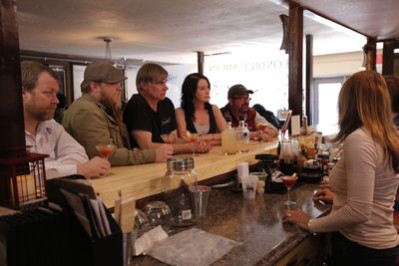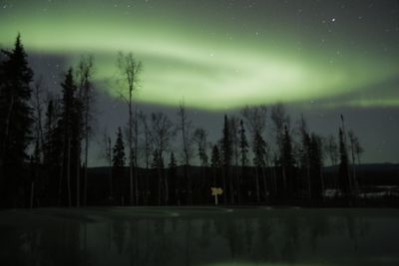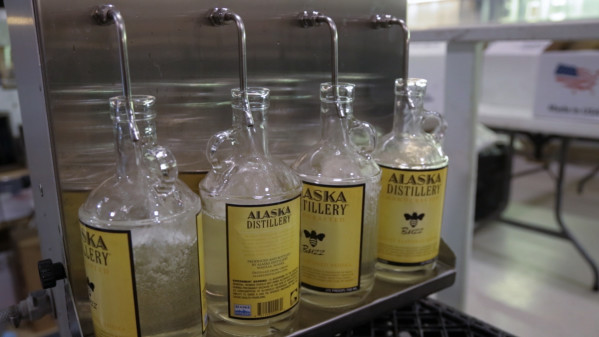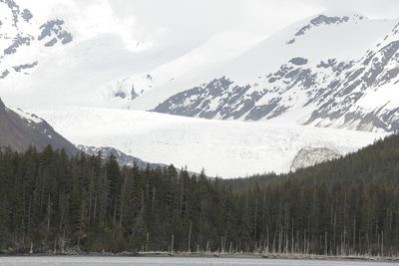INTERVIEW: Making vodka from Alaska’s ingredients on ‘Alaska Proof’

Toby Foster, CEO and founder of Alaska Distillery, has a saying for his burgeoning spirits business: He likes to put a little bit of Alaska in every bottle.
In many ways, Foster is being quite literal with that slogan. Alaska Distillery uses glacial water and icebergs harvested from Prince William Sound, in addition to Alaska Matanuska potatoes, Alaska birch syrup, wild blueberries and more. Foster’s unique company is now the subject of a new Animal Planet reality series. Alaska Proof is set to premiere Thursday, Jan. 14 at 9 p.m.
Joining Foster on the series is his sidekick dog, Hooch; Scott Lindquist, master distiller; Shane Reeves, expedition leader; Chrissy Grunzke, assistant manager; and Andy King, general manager.
“Back in 2011, we had a reporter from Outside magazine came up, and he did a story on Alaska Distillery and our use of glacier icebergs, and Scott Lindquist and the making of our products,” Foster said recently during a phone interview. “Within a week of that article being published, we had about a dozen different production companies calling us wanting to do a potential reality show about Alaska Distillery because we’re so unique and much different than anything else out there.”

Before entering the spirits business, Foster was actually a medevac pilot. He worked in that profession for about a decade, but after a “very serious plane crash in western Alaska,” an accident that left him with a broken back, the future founder of Alaska Distillery stepped away from the aviation business.
“During the time I was recovering I was visiting my grandmother in the hospital, and she told me this story I hadn’t heard before about my grandfather,” he said. “He was a farmer in western Colorado, and back in the day all the farmers had a moonshine distill on their property because if you have a surplus of grain at harvest, it’s going to rot over the wintertime. And so you need to turn that into a commodity that you can sell. Either barter for things you need, or you can put it into your tractor. And so I got thinking, well, you know, I know my grandfather. If he can do this, I can do it. And that was kind of the impetus that started Alaska Distillery.”
Foster cashed out his 401K plan, gathered up his “very meager savings” and started building the distillery with his son, who was 10 years old at the time. He cleared some property in southern Alaska and built the facility by hand. In the early days, Alaska Distillery was essentially a glorified wooden shack, a combination of used lumber and stuff purchased off Craigslist.
“Our funds were very, very limited, and then I taught myself the art of distilling, read a lot of books, asked a lot of questions,” he said. “And we went to market about two years after I got the spark there to start the distillery, and it’s been a wild ride ever since, hasn’t stopped.”

When his team was putting together the original concoctions, there was much trial and error in the process. Foster even found some of the early results discouraging. “I mean nothing was working — nothing,” he said of an early recipe. “And it was just trial and error. Each time you tried something different. You read more, and you ask questions. And you meet people, and it took a long time. … But I had help from a lot of great resources and a lot of really knowledgeable people.”
Today’s distillery operation Foster likes to call “distillery version 2.0.” From those humble, wooden-shack beginnings with no electricity or running water, Foster has grown the business into a 6,000-square-foot facility with a few more trusted employees.
“We had to bring water in by hand,” Foster said of the original operation. “It didn’t even have a bloody road. The nearest access was about 100 yards away, so the kids would roll up bottles and materials on sleds or a wheelbarrow and truck it down to the distillery. … But we sold 500 bottles our first week, and it really blew us away. It just resonated with people, and so we moved out of our cabin within the year and then moved into our new facility.”

Today, Alaska Distillery products can be found in 12 states outside Alaska, plus Canada and Singapore. There are 14 offerings, including Permafrost and Frostbite vodkas, plus three more on the way. “Yeah, we’ve grown exponentially over the years, but we’re still relatively a small company,” he said. “And we still have those small-company challenges that all little companies go through, but I’ve got some great people working with me. And I work in probably the coolest place on the planet.”
Foster bleeds Alaska, and he’s dedicated to putting local ingredients in the spirits. “We use glacier ice in all of our products, but our number one selling product is called Permafrost,” he said. “And it’s made from potatoes. Almost all vodkas on the market and spirits on the market is made from grain because grain has a higher yield, has more carbohydrates to convert into simple sugars. It’s cheaper. The profit margins are higher. Potatoes are messy. The yield is low, but you get a far superior spirit when you use potatoes. So all of our products are grain, except for Permafrost, and Permafrost is our number one seller.”
Permafrost won a Platinum Medal from the 2009 International Review of Spirits, receiving 96 points (a superlative rating), an accolade Foster is quite proud of.
“It’s been unbelievable,” he said. “It’s been a roller coaster. We’ve had a lot of challenges. I mean we’ve had the lights turned off a couple of times because we couldn’t pay our bills in the early days. Had no idea that it would blossom into what it is. … I’d like to share Alaska and our products really with the world. My biggest move is to make it a really awesome place for people to work, the best place in Alaska to have a job, where people can come and visit us, and hear the story and take a bottle back home.”
By John Soltes / Publisher / John@HollywoodSoapbox.com
- Alaska Proof premieres Thursday, Jan. 14 at 9 p.m. on Animal Planet. Click here for more information.


This is really interesting! It’s hard to find Vodka made from potatoes as it was originally made, I believe, in Russia. I watched part of a program showing the team removing something from trees that looks like “burls”. What is it called is what I’d like to know, and what tree does it come from? Does anyone out there know?